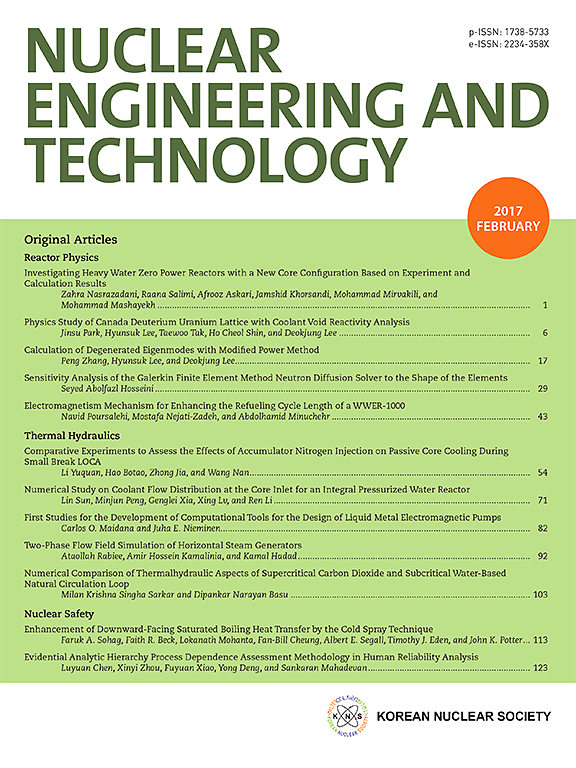Development of CFD porous model parameters of Korean PWR spent nuclear fuel assemblies for thermal analysis
IF 2.6
3区 工程技术
Q1 NUCLEAR SCIENCE & TECHNOLOGY
引用次数: 0
Abstract
This study focused on developing and validating porous model parameters to accurately estimate the thermal behavior of spent nuclear fuel assemblies for computational fluid dynamics simulations. These assemblies are stored in Korean pressurized water reactors (PWRs) under dry storage conditions. Korean PWR fuel assemblies were categorized into four distinct types based on their configuration, facilitating the calculation of effective thermal conductivities and flow resistance coefficients. These parameters are crucial for simulating heat transfer and determining the peak cladding temperature (PCT), ensuring the thermal safety of stored nuclear fuel. The validation of the proposed porous model against explicit two-dimensional and three-dimensional simulations demonstrated its efficacy and reliability in enhancing the thermal analysis of spent fuel assemblies, highlighting the significance of accurately calculating the porous model parameters in the safety assessment of nuclear fuel storage. Furthermore, the study assessed the sensitivity of variables influencing temperature during spent nuclear fuel storage, focusing on flow resistance coefficients, control rod effect, and basket size. The findings revealed that variations in flow resistance and the presence of control rods minimally impacted PCT, whereas basket size significantly influenced temperature, underscoring its importance in the thermal analysis of nuclear fuel storage systems.
求助全文
约1分钟内获得全文
求助全文
来源期刊

Nuclear Engineering and Technology
工程技术-核科学技术
CiteScore
4.80
自引率
7.40%
发文量
431
审稿时长
3.5 months
期刊介绍:
Nuclear Engineering and Technology (NET), an international journal of the Korean Nuclear Society (KNS), publishes peer-reviewed papers on original research, ideas and developments in all areas of the field of nuclear science and technology. NET bimonthly publishes original articles, reviews, and technical notes. The journal is listed in the Science Citation Index Expanded (SCIE) of Thomson Reuters.
NET covers all fields for peaceful utilization of nuclear energy and radiation as follows:
1) Reactor Physics
2) Thermal Hydraulics
3) Nuclear Safety
4) Nuclear I&C
5) Nuclear Physics, Fusion, and Laser Technology
6) Nuclear Fuel Cycle and Radioactive Waste Management
7) Nuclear Fuel and Reactor Materials
8) Radiation Application
9) Radiation Protection
10) Nuclear Structural Analysis and Plant Management & Maintenance
11) Nuclear Policy, Economics, and Human Resource Development
 求助内容:
求助内容: 应助结果提醒方式:
应助结果提醒方式:


